Rustic Chinese napa cabbage salad recipe
Rustic Chinese napa cabbage salad recipe is the perfect addition to your winter dinners. Sweet and creamy, this delicious side dish will pease both grown ups and young eaters alike.
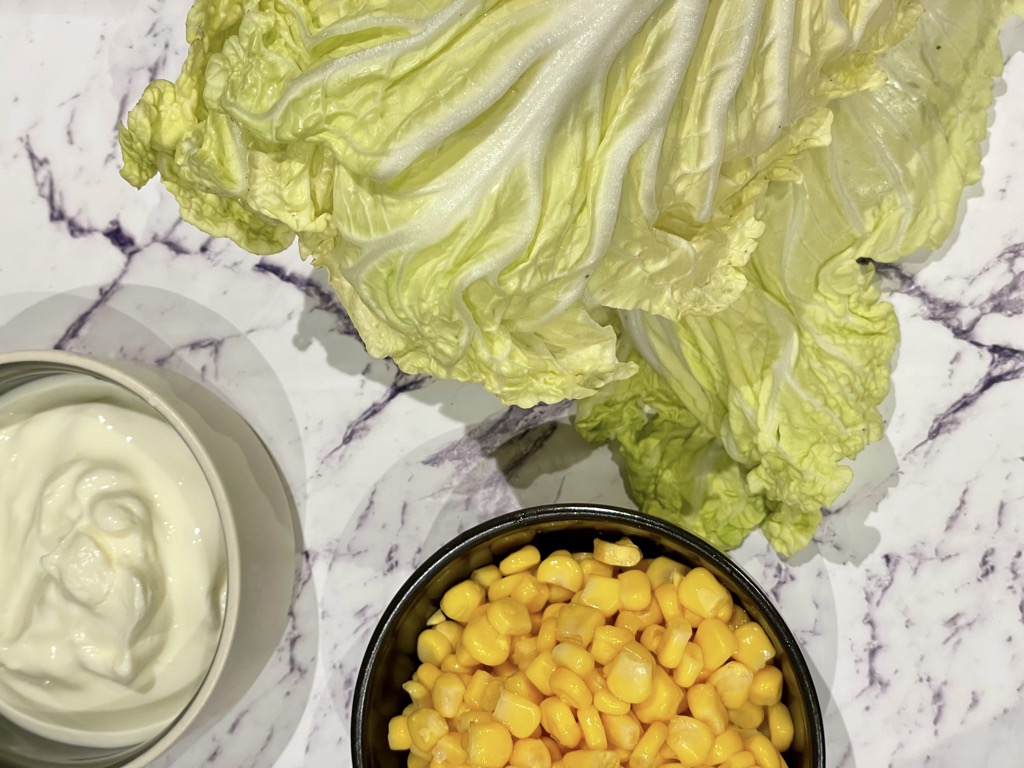
When the colder season rolls around and the cravings for hearty, creamy dishes kick in it can feel hard to add a salad to your plate. While warm, sunny days are often filled with fresh, raw produce, the cozier time of year tends to be more centered around baked dishes, soups and carb heavy meals.
This is where this easy napa cabbage salad recipe shines. Crunchy cabbage is paired with hearty sweet corn and topped with a creamy dressing, making it the perfect winter salad. I remember loving this dish as a kid, and over the years I have come back to it time and time again. It‘s one of those old school salads, that should never be forgotten about.
Ingredients you’ll need for this easy napa cabbage salad recipe
Napa cabbage, or Chinese cabbage, is the star of the show. Commonly found in your standard supermarket, this crunchy pale vegetable is one of those vegetables not many know what to do with. We‘ll make sure to change that.
Sweet corn. If you have time, fresh steamed or roasted corn is going to be amazing in this salad. In our house, fresh corn gets eaten the moment it hits the fridge, so in reality I use canned corn the majority of the time.
Plain yoghurt as the base for our dressing. So many creamy dressings nowadays are based on mayonnaise and cream. Using natural yoghurt instead has the same effect with lesser calories and added probiotics. It‘s also nicer for those with sensitive tummies.
Apple cider vinegar as our acid of choice.
Maple syrup to sweeten the creamy dressing. I love the maple flavour in almost anything and just love to use it in my kitchen. Saying this, if you‘re not a maple person you can also use a little white sugar or another sweetener of choice.
Olive oil – a must in salad dressings.
Salt and Pepper to taste.
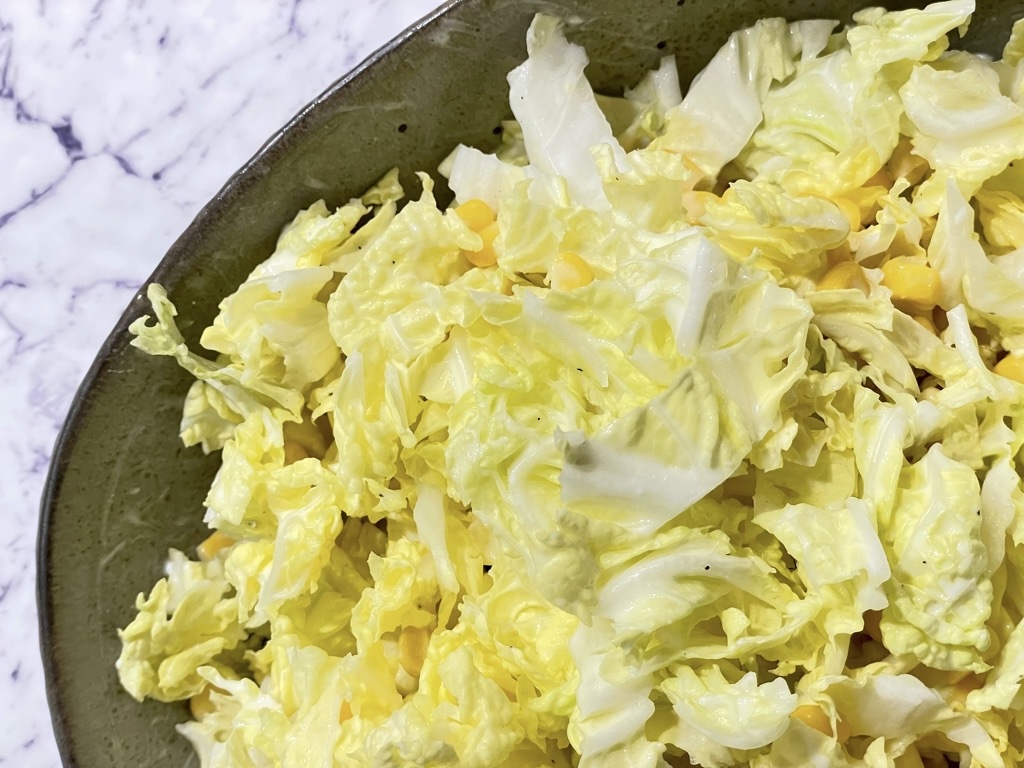
Tips to make my rustic Chinese napa cabbage salad recipe turn out perfect
Finely shred the napa cabbage. While the tips of our cabbage leaves are soft and easy to chew, the back half of the cabbage is thicker and much more awkward to fit into your mouth. Once you reach the thicker part of the leaves, focus on shredding the cabbage into fine strips, and possibly even half them again once shredded.
Roast fresh corn for an exciting, deep range of flavours. As I mentioned earlier, the reality is that fresh sweet corn doesn‘t last long in our house. But if you do have a cob or two available, take the extra time to oven roast it and use it in your salad. A few charred pieces add so much more colour and flavour to this salad and make it extra special.
More is more when it comes to dressing. There‘s just something about a creamy dressing coating vegetables. Thankfully, you don‘t need to worry about high fat or calorie contents wen using my yoghurt dressing in this salad. Add as much as you like and if my recipe doesn‘t satisfy the quantity you‘re after, simply make another batch of dressing.
Serve the dressing on the side. Here‘s the thing, I sometimes overestimate the amount of food people eat. I‘m a good eater myself and so is my husband, and we often eat a 4-6 serve recipe between the two of us. But I also know the rest of the world might not have the same kind of appetite. So for those occasions where you‘re catering to a crowd or plan on storing any leftovers for the next day, serve the dressing on the side and let everyone mix their own. You can then safely store both separately without anything spoiling.
More favourite vegetable recipes
If you like my easy napa cabbage salad recipe, why not try one of these next:
Mixed salad with sautéed mushrooms
Spiced sweet potato and legumes soup
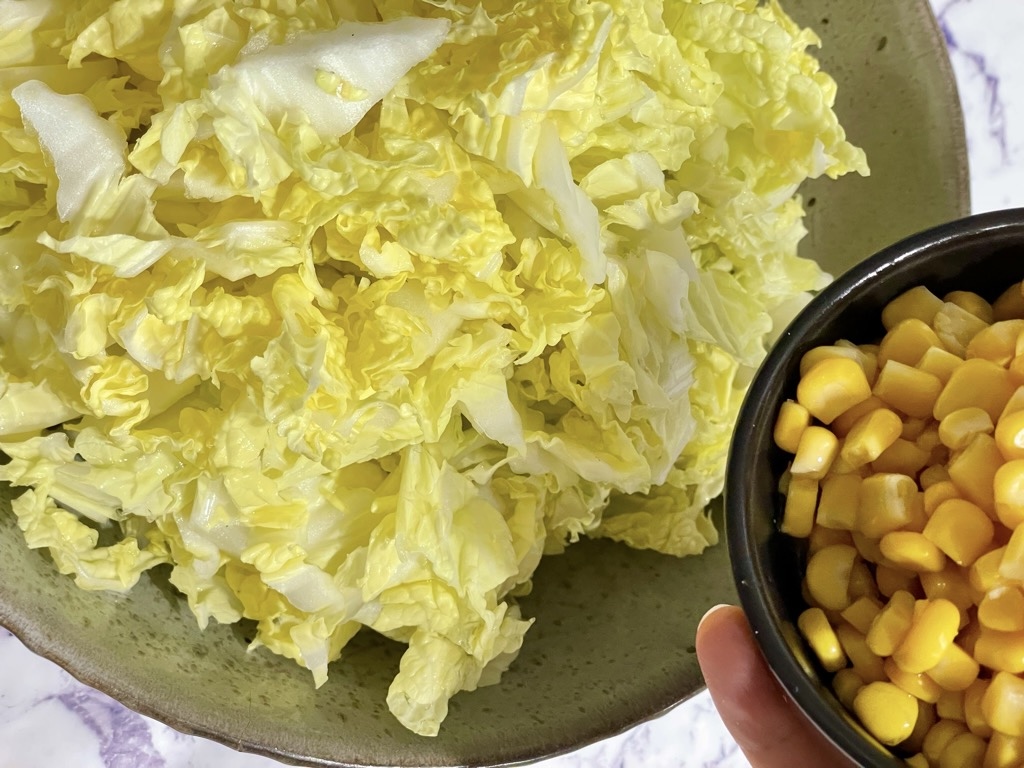
How to make my rustic Chinese napa cabbage salad recipe
Wash your salad and thinly slice it. Focus on creating thin, easy to chew pieces that fit into your mouth. With all that creamy dressing we‘re adding, you want to make sure each fork full fits and you don‘t end up looking like a creamy cookie monster.
Add your corn. If you‘re using fresh steamed or roasted corn, let it cool a little before cutting off the kernels.
To make the creamy dressing, add yoghurt, apple cider vinegar, maple syrup, olive oil, salt and pepper into a small bowl and mix. Once well combined, try a little to see if it‘s sweet enough for your liking. If you can still taste a lot of tanginess from the yoghurt, add a little more maple syrup to balance it.
Pour the dressing over the salad and toss until well combined. Aim to have all vegetables evenly coated in lots of dressing.
Serve with freshly baked sourdough bread or as a side with your favourite winter dinners.
Easy Napa Cabbage Salad variations
If you love my rustic Chinese napa cabbage salad recipe and want to continue exploring the world of easy napa cabbage salad recipes, why not try some of these variations:
Ramen noodles make a great addition to any Asian cabbage salad. Often served as a crunchy topping, these delicious little pieces also look beautiful when served in a large bowl.
Sesame oil is a staple in Asian cooking. Try and swap olive oil for sesame oil to give the dish a completely different flavour.
Green onions are another favourite in topping. Try and combine them with crunchy almonds or sesame seeds, fresh ginger and green bell pepper.
Rice vinegar is my favourite swap for this particular salad, as it adds a similar fruity flavour without changing the entire dish.
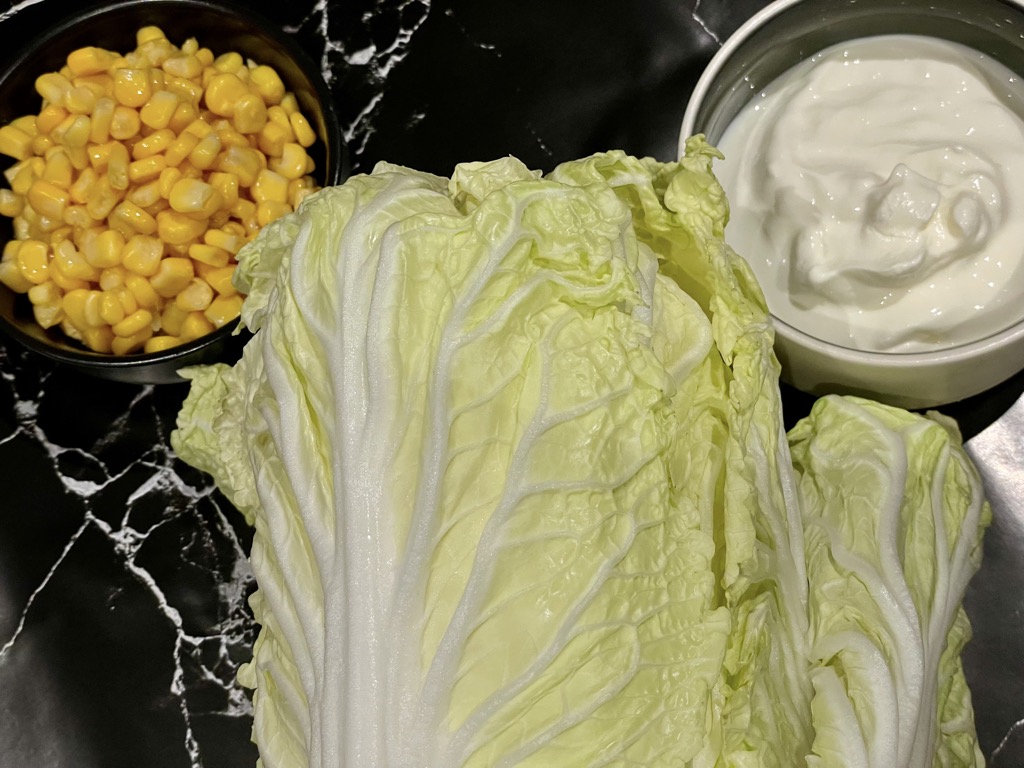
Frequently asked questions
How long does napa cabbage stay fresh?
A fresh head of Napa cabbage can be stored in a dark, cool place for up to a few weeks. When I say up to, you will find that the duration varies greatly between farm fresh and supermarket produce. Farm fresh cabbage was likely only harvested a day or two before being sold. Supermarket produce often travels great distances for days and gets stored before being shipped or sold. This means that produce has been harvested a far greater time ago and is therefore likely to meet its due date sooner that the farm fresh counterparts.
How do you store napa cabbage after cutting?
Napa cabbage is one of those vegetables that often gets too much time on the supermarket shelf. My personal belief is that this has caused some to fear it as a very fragile vegetable. The reality is, a fresh head of cabbage is no harder to store than a bell pepper or zucchini.
If you have only cut part of the napa cabbage and want to store an entire half for future use, simply wrap your cabbage in plastic. An airtight container works just as well, although many of us may not have the required size on hand. If the cabbage has already been chopped and you would like to store the leftovers for later, a damp towel often does the trick. Similar to other leafy vegetables, cut edges cause the vegetable to lose water. The result are soggy leaves. To prevent this from happening, wrap the cut cabbage in a damp towel and store it in the fridge. Aim to use it within a couple of days.
How do you take the bitterness out of napa cabbage?
Like many other types of cabbage, napa cabbage can have quite a bit of bitterness to it. For hot dishes, blanching is usually the easy choice to naturally sweeten the vegetable. In cold dishes like my rustic Chinese napa cabbage salad recipe, we do however want to keep the vegetable raw and crunchy. A sweet, creamy dressing is easily combined and whipped up in minutes and helps the dish showcase the sweet notes it naturally possesses. This is a great way to integrate cold cabbage to your daily meals as a side dish.
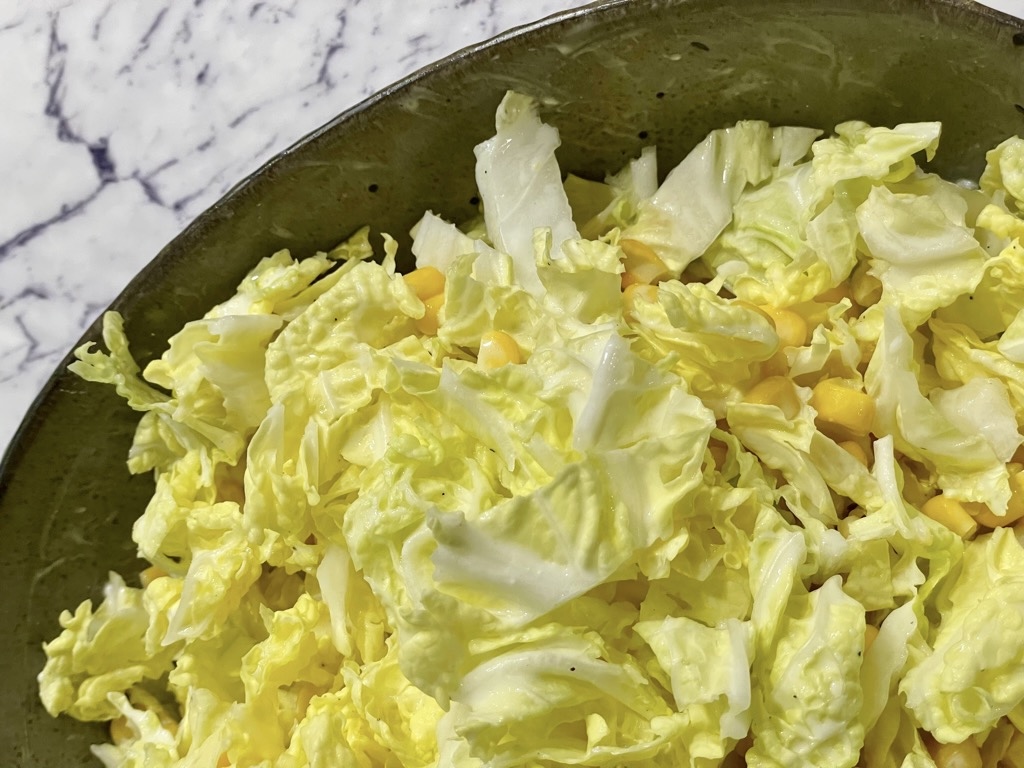
Why does salad get soggy after you put dressing on it?
If you were ever late for dinner, or have packed a leftover salad, chances are you’re familiar with soggy salad. But why does salad get soggy after putting dressing on it? It’s the acid in your dressing. Vinegar, lemon juice or other acids you add to the oil to create your salad dressing, sadly cause produce to soften. It breaks down the cell structure of your produce, which in turn releases the vegetables’ liquid. The result is soft, mushy produce. If you are catering to a crowd, or are sure to have excess salad left, try and serve the dressing on the side. This will allow you to store any leftovers in separate containers for the next day.
What primary ingredient is used in most salad dressings?
Most salad dressings have two basic ingredients, a fat and an acid. The fat often comes in the form of oil, such as olive, sesame or avocado oil. The acid is usually a type of vinegar, such as apple cider, red or white wine. Italian cuisine uses its popular balsamic vinegar for a great range of tomato dishes, while other alternatives such as rice wine vinegar are more commonly featured in Asian cuisine.
Once these two main ingredients are combined, additional ingredients are added to complement and balance the salad’s ingredients. My favourite additions are mustard, yoghurt and maple syrup, as these pair well with most of my rustic dishes. Add a little salt and pepper and your dressing is complete.

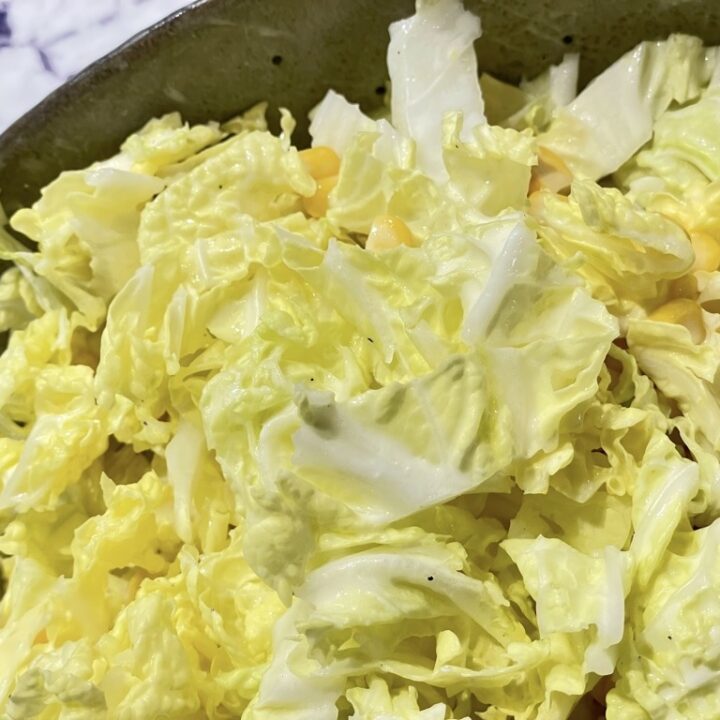
Rustic Chinese napa cabbage salad recipe
Sweet and creamy, this delicious side dish will pease both grown ups and young eaters alike.
Ingredients
- 1 Head of Chinese Napa Cabbage
- 1 Cup corn kernels
- 1.5 Cups plain yoghurt
- 2 Tbsp olive oil
- 1 Tbsp Apple cider vinegar
- 1 Tbsp Maple syrup - more if desired
- Salt and Pepper
Instructions
- Wash your salad and thinly slice it. Focus on creating thin, easy to chew pieces that fit into your mouth. With all that creamy dressing we‘re adding, you want to make sure each fork full fits and you don‘t end up looking like a creamy cookie monster.
- Add your corn. If you‘re using fresh steamed or roasted corn, let it cool a little before cutting off the kernels.
- To make the creamy dressing, add yoghurt, apple cider vinegar, maple syrup, olive oil, salt and pepper into a small bowl and mix. Once well combined, try a little to see if it‘s sweet enough for your liking. If you can still taste a lot of tanginess from the yoghurt, add a little more maple syrup to balance it.
- Pour the dressing over the salad and toss until well combined. Aim to have all vegetables evenly coated in lots of dressing.
- Serve with freshly baked sourdough bread or as a side with your favourite winter dinners.
Notes
- Finely shred the napa cabbage. While the tips of our cabbage leaves are soft and easy to chew, the back half of the cabbage is thicker and much more awkward to fit into your mouth. Once you reach the thicker part of the leaves, focus on shredding the cabbage into fine strips, and possibly even half them again once shredded.
- Roast fresh corn for an exciting, deep range of flavours. As I mentioned earlier, the reality is that fresh sweet corn doesn‘t last long in our house. But if you do have a cob or two available, take the extra time to oven roast it and use it in your salad. A few charred pieces add so much more colour and flavour to this salad and make it extra special.
- More is more when it comes to dressing. There‘s just something about a creamy dressing coating vegetables. Thankfully, you don‘t need to worry about high fat or calorie contents wen using my yoghurt dressing in this salad. Add as much as you like and if my recipe doesn‘t satisfy the quantity you‘re after, simply make another batch of dressing.
- Serve the dressing on the side. Here‘s the thing, I sometimes overestimate the amount of food people eat. I‘m a good eater myself and so is my husband, and we often eat a 4-6 serve recipe between the two of us. But I also know the rest of the world might not have the same kind of appetite. So for those occasions where you‘re catering to a crowd or plan on storing any leftovers for the next day, serve the dressing on the side and let everyone mix their own. You can then safely store both separately without anything spoiling.
